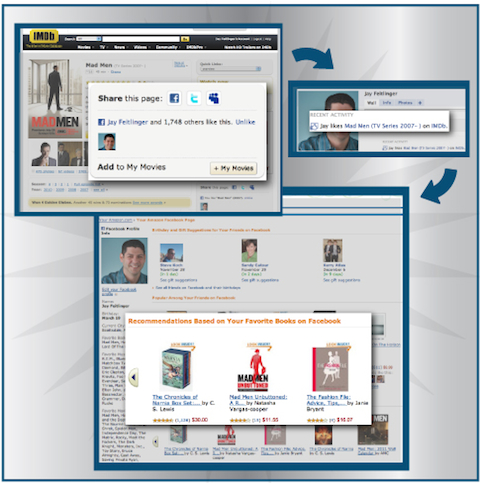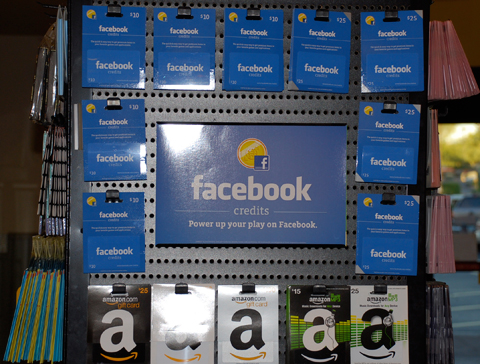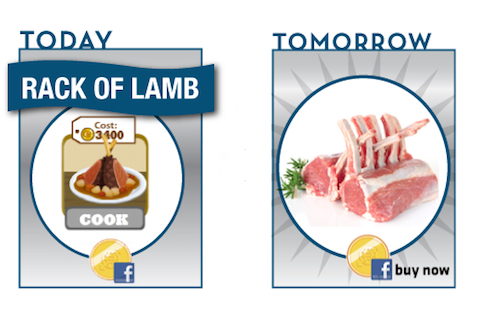 At the Facebook f8 conference earlier this year, founder and CEO Mark Zuckerberg unveiled Open Graph as “the most transformative thing we’ve ever done for the web” and with that announcement, the disparate strands of the world wide web became more tightly woven.
At the Facebook f8 conference earlier this year, founder and CEO Mark Zuckerberg unveiled Open Graph as “the most transformative thing we’ve ever done for the web” and with that announcement, the disparate strands of the world wide web became more tightly woven.
At the time, and to my surprise, mention of Facebook Credits was minimal at best—but as more information becomes available, it’s my prediction that Facebook Credits will be the NEXT major step Facebook takes toward unifying the online experience from simple, social interactions to true social commerce (or when tied to Facebook commerce, labeled as fCommerce).
Before we dive into where I see that going, here’s a quick recap of what Facebook Open Graph is and how it lays the foundation for Facebook Credits to revolutionize the online experience for users and marketers alike.
An Open Graph Recap
The Open Graph protocol enables any web page to become a rich object in a social graph. A website owner can add a few lines of code to connect his or her site to Facebook, so what a user does off Facebook provides Facebook behavioral data about that user. At its simplest form is the Facebook Like button that has made its way onto websites of all types and sizes.
For example, if a Facebook user visits IMDB.com (one of the more than 1 million partner websites utilizing the Open Graph protocol) and Likes the Mad Men TV show, this interaction would immediately update the user’s Facebook profile with additional psychographic data on his likes and interests.
When the same user is logged into Facebook, that updated psychographic profile data becomes very beneficial for marketers. During the fourth season of Mad Men, Unilever created a series of six retro commercials to be aired during the show. Unilever can now leverage that Like on IMDB to create a very targeted ad campaign on Facebook. This is why Facebook Ads can be highly effective as they target both demographic and psychographic data.

But the use of Open Graph gets even more interesting.
When that user visits another Open Graph partner site such as Amazon.com, Amazon knows the user likes Mad Men based on what he did on IMDB and can now showcase books, music and other products such as the Mad Men soundtrack. With over 1,000,000 sites currently incorporating Open Graph, Facebook becomes the hub of an amazing amount of data and provides websites the ability to truly personalize the social commerce experience to each individual visitor if the site integrates with Facebook.
Enter Facebook Credits
For those not familiar with Facebook Credits, they are a virtual currency you can use to buy virtual goods in over 100 games and applications on the Facebook platform such as Farmville with approximately 54,000,000 monthly active users and Mafia Wars with over 22,000,000 monthly active users.
But based on my prediction, Facebook Credits will no longer just be for games but also for actual real-world transactions!
As Casey Hibbard pointed out in her article entitled Cold Stone Transforms the Ice Cream Social With Facebook, companies are finding creative ways to leverage virtual gifts to engage with fans. Even though Cold Stone Creamery used a different payment processing system, the concept is the same and the results were amazing with 66,000 new fans and $10,000 in incremental sales.
It’s clear that people are comfortable with virtual goods, but to take this to the next level, Facebook Credits will need to translate into real-world products or services.
Today, the Facebook Open Graph protocol comes with 8 social plugins to simplify the integration for website owners to leverage Open Graph. One not in the suite YET is ecommerce Social Plugin—also known as Facebook Credits.
Get World-Class Marketing Training — All Year Long!
Are you facing doubt, uncertainty, or overwhelm? The Social Media Marketing Society can help.
Each month, you’ll receive training from trusted marketing experts, covering everything from AI to organic social marketing. When you join, you’ll also get immediate access to:
- A library of 100+ marketing trainings
- A community of like-minded marketers
- Monthly online community meetups
- Relevant news and trends updates
This is where the future takes hold and how I can see this exploding into a completely personalized and comprehensive social commerce experience, powered by Facebook, driving a plethora of data back to Facebook and into the hands of marketers (which of course drives more revenue to Facebook).
According to Amy Porterfield’s article entitled 3 Studies That Show Facebook’s Marketing Potential, 35% of ecommerce companies had already implemented the Facebook Like social plugin indicating the Open Graph protocol has been rapidly adopted by many businesses such as Levi’s Facebook Friends Store, and demonstrating the potential for rapid penetration of other similar Facebook programs such as Facebook Credits.
Reflecting back to the previously mentioned user’s experience on Amazon, the Buy Now button next to that Mad Men soundtrack becomes Visa, Amex, PayPal, and oh, Facebook Credits. In theory, a user could complete a transaction on these sites using Facebook Credits.
Now of course, for every transaction you make, Facebook is making 30% of that sale AND collecting an amazing amount of data on the user. Facebook and partner sites know you like certain things but if you BUY things that support those interests, Facebook now knows you REALLY like those products. This changes everything! Facebook Ads would now have another level of targeting such as behavioral ads based off prior transactions.

Discover Proven Marketing Strategies and Tips
Want to go even deeper with your marketing? Check out the Social Media Marketing Podcast! Publishing weekly since 2012, the Social Media Marketing Podcast helps you navigate the constantly changing marketing jungle, with expert interviews from marketing pros.
But don’t let the name fool you. This show is about a lot more than just social media marketing. With over 600 episodes and millions of downloads each year, this show has been a trusted source for marketers for well over a decade.
Move Over, Visa Rewards
The Internet is becoming more saturated and consumers are going to get even more impatient. Facebook Open Graph websites today can personalize the experience for the user based on his Facebook profile. However, businesses are going to need loyalty and incentive offers to guarantee return visits to the site.
If I’m an active user on your site, give me some recognition. I’ll take Facebook Credits as a reward for things I do on your site or even in your brick-and-mortar store. I can then use those credits to process transactions both on- and offline.
Today, I use my Visa card and collect points based on how much I spend and can use those points to order “free” products. I continue to use my Visa rewards card instead of a competing credit card to make a purchase because of this incentive to earn products or services. Grocery stores also have loyalty programs that encourage repeat purchases because the more I shop, the more rewards I’ll receive when I use my loyalty card.
What would happen if one card provided both loyalty and the ability to complete transactions and had the huge base of users like Facebook does?
For example, if I accepted Facebook Credits on my website or in my store and it “cost” the customer 100 Facebook Credits to purchase the item, I would get 70 credits paid and Facebook would take the other 30 credits as their fee. This is similar to how Apple.com takes a percentage of revenue with their paid apps and other credit card companies charge merchants transaction fees. Definitely Facebook’s 30% is quite a bit more aggressive. The fee Facebook charges is definitely one area that would need to be analyzed before this could become widely adopted.
Now, what if the 100 Facebook Credits the consumer used were earned credits from activities such as commenting on websites, Liking products and other behaviors? No money changes hands but activity takes place and the user is rewarded with Facebook Credits to make the transaction possible—activity that further enhances the website’s brand and improves advertising targeting.
Paid in Data
Ultimately Facebook becomes the new payment processor + loyalty program of the future and no other current service comes close to competing.
The behavioral data that’s collected through the implementation of Open Graph and the ultimate penetration of ecommerce is priceless from a marketing perspective and would likely help businesses significantly increase transactions and revenue as the targeting of consumers would be spot-on.

To make this happen:
- Facebook will launch a new social plugin (ecommerce).
- Companies will integrate the Facebook Connect ecommerce program into their websites and start leveraging Facebook Credits as their new loyalty program, as well as provide an end-to-end commerce platform.
- Facebook supports real-world transactions connecting well over 500 million users to the consumption of pretty much anything. Facebook credits currently cost $5.00 for 50 credits, $10.00 for 100 credits and so forth, and can now even be purchased at 7-Eleven, over 20,000 CoinStar machines, Wal-Mart, Best Buy, and as of this week, my grocery store, to name a few.
- Credits become an alternate form of currency on both transaction-based sites and brick-and-mortar stores.
Today you can use Facebook Credits to buy a virtual rack of lamb, and if my prediction comes true, you’ll soon use your Facebook Credits card to purchase a real rack of lamb from your local supermarket.

How Facebook integrates Facebook Credits into more than just gaming is of great interest. It was the many conversations at the f8 conference with product managers that inspired my vision for an all-encompassing web commerce experience with Facebook as the common thread.
Jay Baer, author of The Now Revolution, states that “Facebook wants to be the plumbing of the Internet—indispensable and everywhere. Credits are their gateway to being relevant in three dimensions. People often cite that Facebook would be the third-largest country in the world, based on its user base. So, for them to create their own currency shouldn’t be a surprise. If Credits get even a minor toehold as a payment mechanism, the opportunity for Facebook to weave itself even tighter into the fabric of day-to-day life will get a huge boost.”
Conclusion
This is the future of social commerce! A place to bring social interaction and consumer spending together to breach the “walls” of the Internet. Get yourself ready and start thinking about how you’re engaging with customers today. If you want to take a break, go and experiment with how Facebook Credits work. That way, when my prediction comes true, you’ll be ready.
Sorry Visa, but your slogan “It’s everywhere you want to be” just might become the new tagline for Facebook Credits.
What do you think? Do you feel Facebook Credits could become the next transformative step Facebook takes toward unifying the online experience from simple, social interactions to true social commerce? Leave your comments in the box below.
Attention Agency Owners, Brand Marketers, and Consultants

Introducing the Marketing Agency Show–our newest podcast designed to explore the struggles of agency marketers.
Join show host and agency owner, Brooke Sellas, as she interviews agency marketers and digs deep into their biggest challenges. Explore topics like navigating rough economic times, leveraging AI, service diversification, client acquisition, and much more.
Just pull up your favorite podcast app, search for Marketing Agency Show and start listening. Or click the button below for more information.

